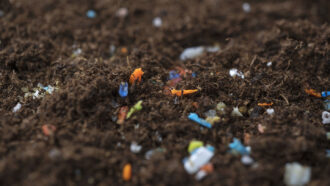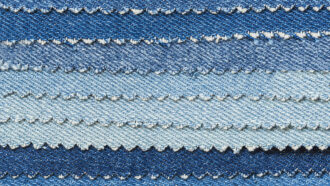Unnatural disasters
The actions of people can make the destruction caused by hurricanes worse than it would be otherwise.
By Emily Sohn
On Aug. 29, Hurricane Katrina slammed into the southeastern United States and dumped more than a foot of rain in some places. Gusts of wind topped 140 miles per hour, and the ocean rose as high as 20 feet above its normal level. Floods followed, leaving New Orleans and coastal towns in Louisiana and Mississippi underwater.
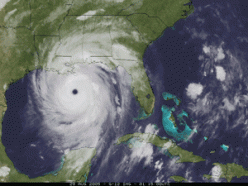 |
|
This satellite image shows Hurricane Katrina over the Gulf of Mexico before it slammed into the coast of southeastern United States on Aug. 29.
|
| NASA |
Hundreds of thousands of people fled before the storm hit, but many others were left stranded on rooftops, floating on makeshift rafts, and separated from their families. Some went without food or water for days. Hospitals lost power. Telephone systems failed. Hundreds of people died.
Hurricane Katrina was one of the deadliest and most costly natural disasters in living memory. But how “natural” was it?
“The phrase ‘natural disaster’ misses the point,” says geologist Jeffrey Mount of the University of California, Davis. “This is only a disaster because people got in the way. Hurricanes are a natural process.”
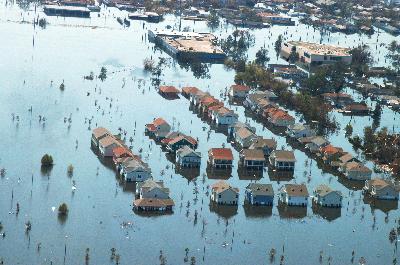 |
|
In New Orleans after Hurricane Katrina, floodwaters swamped houses.
|
| Photo by Liz Roll, FEMA |
In this latest encounter between people and nature, nature seems to have won. Some analyses suggest, however, that human actions made the destruction caused by Hurricane Katrina worse than it might have been. There were also things that people could have done beforehand to lessen the hurricane’s impact.
In fact, as horrifying as Katrina was, its effects weren’t a complete surprise. For years, scientists and engineers had been warning that just such a storm could flood New Orleans and wipe out coastal communities.
Natural disasters
Five years ago, in his book Acts of God: The Unnatural History of Natural Disaster in America, historian Ted Steinberg reported the good news: In modern times, fewer people are dying in natural disasters, thanks to improved systems of communication, refined methods of tracking weather, and better evacuation plans.
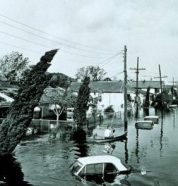 |
|
New Orleans has suffered a number of floods over the past 100 years. This photo was taken in 1965, when Hurricane Betsy caused the flooding of 164,000 homes in the city.
|
| R. Vetter, American Red Cross, NOAA Photo Library |
Steinberg described a major hurricane that hit Florida in 1928, killing 2,000 people, and a massive earthquake in San Francisco that took thousands of lives in 1906, among other long-ago disasters.
“But I said at that point in the book that if there were any place where it was possible to see a return to the mass death we saw in 1928 and 1906, it’s New Orleans,” Steinberg says. “Anybody, going back 10 or 15 years, could see this was a disaster just waiting to happen.” Steinberg is a professor at Case Western Reserve University in Cleveland, Ohio.
New Orleans sits on the Mississippi River delta, where the river dumps into the Gulf of Mexico. For hundreds of years, the river deposited silt throughout the delta. Flooding was a regular occurrence.
Surrounding marshes were dense, nearby islands were in good shape, and both absorbed the impact of hurricanes that regularly hit the area during the summer (see “Saving Wetlands”).
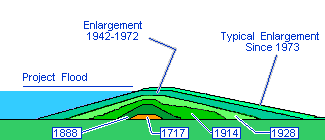 |
|
The levees protecting New Orleans have grown higher and wider over the years. This diagram shows the cross-section of a typical levee at various times, from 1717 until 1973. How have its size and shape changed?
|
| U.S. Army Corps of Engineers |
Then, starting in the 1880s, engineers built levees, or wall-like barriers, around New Orleans to protect it from floods and hurricanes. The levees were designed to keep water out of the city in the face of storm surges from hurricanes, which raise the water level, or of flooding by the Mississippi River. At various times in the past 100 years, these levees were extended and built higher.
Sinking land
Since the levees were built, the city has not had regular flooding. Silt no longer builds up. As a result, the ground under New Orleans has been sinking for years. It’s the only city in the United States that sits largely below sea level. It’s somewhat like a bowl surrounded by water.
Over the years, the construction of roads, homes, and buildings has caused erosion of the coast and offshore islands. The waters of the Gulf of Mexico are much closer to the city than they had been in the past.
“Now, when hurricanes come,” Mount says, “the natural shock absorber of the delta is gone, increasing the impact of storm surges.”
 |
|
The Chandeleur Islands are about 100 kilometers east of New Orleans. The image on the left was taken in July 2001. The image on the right was taken on Aug. 31, 2005, 2 days after Hurricane Katrina. High water created by the storm surge and large waves submerged the islands, stripped sand from the beaches, and eroded large sections of the marsh. There are very few recognizable landforms left. |
| U.S. Geological Survey |
Levees can’t take all the pressure. Over time, as water piles up, it works its way through the structures and erodes them from the inside out. Then, with pressure from fast-moving water during major storms such as Katrina, the levees collapse.
“Most levee engineers will tell you that there are two kinds of levees,” Mount says. “Those that have failed, and those that will fail.”
Theoretically, taller, stronger levees could have saved New Orleans, Mount says. But at some point, it becomes too expensive to build structures strong enough for all possible situations.
Levees can also be dangerous, Steinberg says, because they make residents feel safer than they actually are. The city grows, and that puts even more people at risk.
Prevention
Scientists are now looking for ways to prevent similar disasters from happening again. Some engineers want to deflect floods instead of just blocking them. Other researchers are designing improved storm-resistant buildings and roads. Still others are trying to better predict where hurricanes will go and how hard they’ll hit (see “Recipe for a Hurricane”).
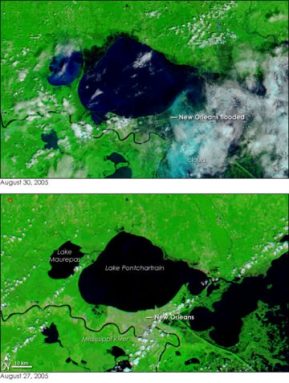 |
|
These satellite images show the damage that New Orleans suffered as a result of Hurricane Katrina. The lower image shows New Orleans and the surrounding area on Aug. 27, 2005, before Hurricane Katrina struck. The upper image shows the city on the morning of Aug. 30, a day after Katrina made landfall. Dark pools of water covered the eastern half of the city, and a large section of Lake Pontchartrain west of the city had engulfed the land. |
| NASA |
In the long run, restoring the environment of the Mississippi River delta will be essential. People will also need to start respecting nature, instead of thinking they can outsmart it. After all, Mount says, animals managed to survive the flooding cycles of the delta for thousands of years.
“But modern humans, with their big buildings, roads, power lines, and houses, are not as well adapted,” he says. “Many of the things we do, such as constructing levees and destroying marshes, make these ‘unnatural disasters’ worse.”
Recognizing the role that people play in natural disasters is an important way to overcome our fear of them, Steinberg says. “You don’t have to see these events as natural disasters beyond our control.”
If we took more seriously what can happen in natural disasters, he says, “we could prevent them from being quite as devastating in the future.”
Going Deeper:





